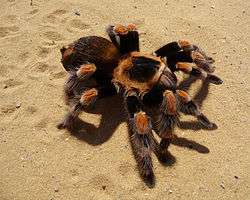Mexican redknee tarantula
| Mexican redknee tarantula | |
|---|---|
 | |
| Mexican red knee tarantula, female. | |
| Scientific classification | |
| Kingdom: | Animalia |
| Phylum: | Arthropoda |
| Class: | Arachnida |
| Order: | Araneae |
| Family: | Theraphosidae |
| Genus: | Brachypelma |
| Species: | B. smithi |
| Binomial name | |
| Brachypelma smithi (F. O. Pickard-Cambridge, 1897) | |
| Synonyms | |
|
Eurypelma smithi | |
Mexican redknee tarantula (Brachypelma smithi) is a terrestrial tarantula native to the western faces of the Sierra Madre Occidental and Sierra Madre del Sur mountain ranges in Mexico. They are a large species, and are a popular choice for enthusiasts. Like most tarantulas, they have a long lifespan.[1]
Description

The mature B. smithi has a dark-colored body with orange patches on the joints of its legs. The second element of the legs is orange-red. Following molting, the colors are more pronounced. The dark portion is very black, while the orange-red portions are far more on the reddish side.
An adult male has a body roughly 4 in long, with a leg span of 6 in, and a mass around 15 g. Both sexes are similar in appearance, with the male having a smaller body, but longer legs. Though the male is of comparable size to the female, the male has a much smaller mass.
Longevity
The Mexican redknee grows very slowly and matures relatively late. The females of this species can live up to 30 years, but the males tend to live for only 5 or so years.
Molting
Like all tarantulas, the Mexican redknee is an arthropod, and must go through a molting process to grow. Molting serves several purposes, such as renewing the tarantula's outer cover (shell) and replacing missing appendages. As tarantulas grow, they regularly molt (shed their skin), on multiple occasions during the year, depending on the tarantula's age.[2] Since the exoskeleton cannot stretch, it must be replaced by a new one from beneath. A tarantula may also regenerate lost appendages gradually, with each succeeding molt. Prior to molting, the spider becomes sluggish and stops eating to conserve as much energy as possible. Their abdomens darken; this is the new exoskeleton beneath. Normally, the spider turns on its back to molt and lies still in that position for several hours. Once this has been accomplished, the tarantula does not eat for several days to weeks, and not uncommonly for up to a month or more after a molt, as its fangs are still soft; the fangs are also part of the exoskeleton and are shed with the rest of the skin.[3] The whole process can take several hours and sheaths the tarantula with a moist new skin in place of an old, faded one.
Behavior
Like most New World tarantulas, they kick urticating hairs from their abdomens and their back legs if disturbed, rather than bite. They are only slightly venomous to humans and are considered extremely docile, though, as with all tarantulas, allergies may intensify with any bite.[4]
They carve deep burrows into soil banks, which keeps them protected from predators, like the white-nosed coati, and enables them to ambush passing prey. The females spend the majority of their lives in their burrows. The burrows are typically located in or not far from vegetation and consist of a single entrance with a tunnel leading to one or two chambers. The entrance is just slightly larger than the body size of the spider. The tunnel, usually about three times the tarantula's leg span in length, leads to a chamber which is large enough for the spider to safely molt. Further down the burrow, via a shorter tunnel, a larger chamber is located where the spider rests and eat its prey. When the tarantula needs privacy, e.g. when molting or laying eggs, the entrance is sealed with silk sometimes supplemented with soil and leaves.[5]
Habitat
Their natural habitat is in deciduous tropical forests in the hilly southwestern Mexico, especially in Colima and Guerrero.[4][5] In 1985, the species was listed as endangered by CITES because the wild-caught specimens shipped for the Chinese market were decreasing in size. The smaller sizes were suspected to be a consequence of a declining population due to excessive export. Exporting is not the only threat, though; some local people have reportedly made a habit of killing these spiders in a nearly systematic way using pesticides, pouring gasoline into burrows, or simply killing migrating spiders on sight.[4] The reasons for these actions seem to be an irrational fear based on myth surrounding B. smithi and related species.[4][6] Thus, whether the listing strengthened the B. smithi wild population or not remains uncertain. The species has nonetheless been bred successfully in captivity, making them readily available on the pet market despite almost no export of wild-caught spiders from Mexico.[4]
References
- ↑ "Tarantulas". National Wildlife Association. Retrieved January 28, 2015.
- ↑ Ramel, Gordon. "Caring for your Tarantula". Earthlife Web. Retrieved August 6, 2012.
- ↑ Overton, Martin (April 4, 2007). "An Introduction to Tarantulas and Scorpions". arachnophiliac.info. Retrieved August 6, 2012.
- 1 2 3 4 5 Schultz, Stanley A. and Schultz, Marguerite J. (2009) The Tarantula Keeper's Guide: Comprehensive Information on Care, Housing, and Feeding (Revised Edition). Barrons.
- 1 2 Locht, A.; Yáñez, M.; Vázquez, I. (1999). "Distribution and Natural History of Mexican Species of Brachypelma and Brachypelmides (Theraphosidae, Theraphosinae) with Morphological Evidence for Their Synonymy" (PDF). The Journal of Arachnology 27: 196–200.
- ↑ "Brachypelma smithi (Cambridge, 1897)". Minax Tarantulas. Retrieved August 6, 2012.
External links
| Wikimedia Commons has media related to Brachypelma smithi. |
- Brachypelma smithi at the World Spider Catalog
- Ondrej Rehak. "Photography of Brachypelma smithi". Tarantulas breeding.
- Mexican Red Knee Tarantula Care and guide
